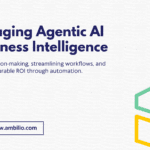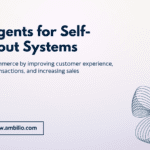Organizations are increasingly adopting agent workflows powered by generative AI to enhance efficiency and improve decision-making. These workflows leverage specialized AI agents to automate complex tasks, streamline operations, and transform business processes. This article examines how enterprises can implement agent workflows, highlighting two significant use cases: loan underwriting and customer support. By integrating these advanced systems, businesses can optimize their operations and deliver better results in critical areas, ultimately redefining their approach to challenges and enhancing overall performance.
Understanding Agent Workflows
Agent workflows are systems that employ autonomous AI agents capable of performing various tasks with minimal human intervention. Unlike traditional automation tools that rely on fixed scripts and rules, agent-based systems leverage natural language processing and machine learning to adapt to changing circumstances. This flexibility allows them to tackle a wide range of tasks, making them suitable for diverse business applications.
Benefits of Agent Workflows
Adopting agent workflows offers several key advantages:
- Increased Efficiency: By automating routine tasks, agent workflows enable employees to focus on more strategic initiatives. This shift not only enhances productivity but also fosters innovation as teams are free to explore new ideas.
- Improved Accuracy: AI agents significantly reduce the likelihood of human errors in data handling and analysis. This enhanced accuracy contributes to better decision-making and minimizes costly mistakes.
- Enhanced Customer Experience: AI agents can provide quicker response times and personalized service, leading to higher customer satisfaction. This responsiveness is especially crucial in today’s fast-paced business environment.
- Scalability: As organizations grow, agent workflows can easily scale to accommodate increased demands. This adaptability ensures that businesses remain competitive without overhauling existing systems.
Steps to Implement Agent Workflows
To effectively adopt agent workflows, enterprises should follow a structured approach:
1. Assess Organizational Needs
Begin by identifying processes that would benefit from automation. Analyze existing workflows to pinpoint inefficiencies and determine where agent workflows can add the most value. Engaging with employees to gather insights about their challenges can also provide a clearer picture of potential improvements.
2. Select the Right Technology
Once needs are assessed, choose a technology platform that supports agent-based systems. Many vendors offer solutions that can integrate with existing software ecosystems. Ensure that the selected technology aligns with organizational goals and has the necessary capabilities for future growth.
3. Pilot Implementation
Implement the agent workflow on a small scale to test its effectiveness in a controlled environment. This pilot phase allows organizations to gather real-world feedback and make necessary adjustments before a full-scale rollout. It’s also an opportunity to identify any technical challenges or user resistance early on.
4. Train Employees
Comprehensive training is crucial to ensure that employees understand how to interact with AI agents and integrate them into their daily tasks. Providing clear instructions and resources will help maximize the benefits of the new system and reduce potential friction.
5. Iterate and Improve
Adopt an iterative approach to continuously refine the agent workflows. Gather feedback from users regularly to understand their experiences and challenges. This ongoing process will help the organization adapt the system to meet evolving business needs and ensure long-term success.

(Agentic AI Use Case in Credit Risk Memos, Source)
Use Case 1: Loan Underwriting
Loan underwriting is a critical process in financial institutions, requiring careful assessment of credit risk for potential borrowers. This process often involves multiple stakeholders, including relationship managers, credit analysts, and compliance teams, making it time-consuming and complex.
How Agent Workflows Transform Loan Underwriting
Implementing agent workflows in loan underwriting can dramatically enhance efficiency and accuracy. Here’s how the process could unfold:
- Initiation: The relationship manager initiates the process by providing a high-level overview of the loan request using natural language. They may specify the borrower’s financial background and the type of loan being requested.
- Task Breakdown: The AI agent interprets the high-level plan and breaks it down into specific tasks. For example, one agent may communicate with the borrower to gather additional documentation, while another agent compiles necessary financial analyses.
- Collaboration: Specialized agents take on different roles—such as a financial analyst agent that calculates key financial ratios and a compliance agent that ensures all regulatory requirements are met. These agents work collaboratively, sharing information and refining analyses as needed.
- Iterative Review: Throughout the process, the system allows for iterative feedback. If discrepancies arise, the relationship manager can communicate directly with the agents to adjust their tasks or request further analysis.
- Final Decision: Once all analyses are complete, the final underwriting decision can be generated efficiently, significantly reducing the time it takes to process loan applications. This system not only speeds up the underwriting process but also improves the overall accuracy of credit assessments.
Use Case 2: Customer Support
In the realm of customer support, providing timely and accurate assistance is crucial for maintaining customer satisfaction and loyalty. Traditional support systems often struggle with high volumes of inquiries, leading to longer wait times and frustrated customers.
How Agent Workflows Enhance Customer Support
Agent workflows can revolutionize customer support by automating responses to common inquiries and facilitating complex issue resolution. Here’s how this can be achieved:
- Natural Language Interaction: Customers can initiate support requests using natural language through chat or voice interfaces. The AI agent interprets the request and identifies the nature of the inquiry.
- Task Allocation: Based on the customer’s needs, the system allocates tasks to specialized agents. For example, a billing inquiry may be directed to a billing agent, while a technical issue could be assigned to a technical support agent.
- Multi-Agent Collaboration: If a customer’s issue requires input from multiple departments, the agents can collaborate seamlessly. For instance, if a billing issue also involves a technical component, both agents can work together to resolve the issue efficiently.
- Continuous Learning: The AI agents can learn from each interaction, continually improving their responses based on customer feedback and previous resolutions. This capability helps the system adapt to evolving customer needs and preferences.
- Faster Resolutions: By streamlining the inquiry process and facilitating collaboration among agents, organizations can significantly reduce response times and improve the overall customer experience. Customers receive quicker, more accurate support, leading to higher satisfaction rates.
Final Words
The adoption of agent workflows in enterprises represents a transformative opportunity to enhance efficiency, accuracy, and customer satisfaction. By understanding the structure and implementation process, organizations can effectively leverage these advanced systems to address complex challenges in areas such as loan underwriting and customer support. As businesses continue to evolve, embracing agent workflows will be essential for staying competitive in an increasingly digital landscape.



